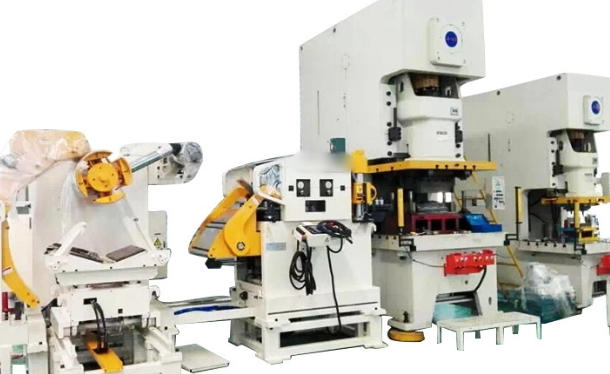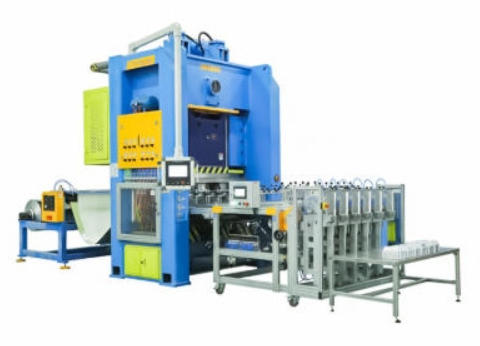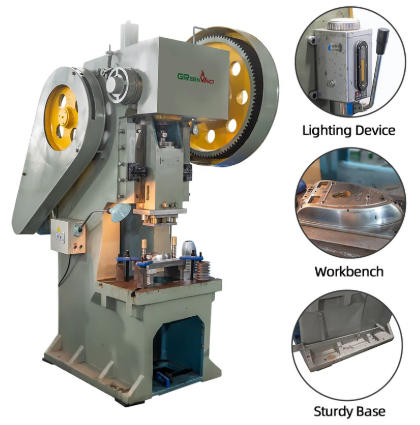Views: 222 Author: Rebecca Publish Time: 2025-11-16 Origin: Site









Content Menu
● How Automated Punch Press Machines Work
● Why Kitchenware Manufacturers Benefit
>> Improved Throughput and Cycle Times
>> Consistent Quality and Tolerances
>> Labor Cost Reduction and Safety
>> Material Versatility and Lightweighting
>> Design Freedom Through Tooling Innovations
● Material and Product Class Considerations
>> Stainless Steel Kitchenware
>> Aluminum Cookware and Utensils
>> Die-Cast vs. Sheet Metal Components
>> Coatings and Surface Treatments
>> Assessing Throughput Targets and Part Volumes
>> Automation Level and Workcell Configuration
>> Quality Assurance and Process Control
>> Maintenance and Tooling Management
● Economic and Environmental Considerations
>> Total Cost of Ownership (TCO)
>> Energy Efficiency and Sustainability
● Case Studies: Real-World Impacts
>> Case Study A: Stainless Steel Utensils
>> Case Study B: Aluminum Bakeware
>> Case Study C: Multi-Component Assemblies
● Potential Risks and Mitigation
>> Cybersecurity and Data Integrity
>> Workforce Transition and Training
● The Road Ahead: Trends Shaping Automation in Kitchenware
>> AI-Enhanced Process Control
>> Collaborative Robots (Cobots)
>> Additive-Constrained Hybrid Lines
● Implementation Roadmap for Kitchenware Manufacturers
● FAQ
>> 1. What types of metal can automated punch presses work with in kitchenware manufacturing?
>> 2. How does automation affect product quality and tolerance control?
>> 3. What considerations are there for safety when implementing automated punch presses?
>> 4. How should a kitchenware manufacturer choose between hydraulic and electric/piston servo presses?
>> 5. What is the typical payback period for an automation project in kitchenware?
Automated punch press machines have emerged as a cornerstone technology for modern kitchenware manufacturing. From lightweight aluminum utensils to precision-cut steel cookware components, these machines enable higher production rates, tighter tolerances, and improved consistency across batches. For kitchenware manufacturers aiming to scale operations, reduce labor costs, and enhance product quality, automation with punch presses offers compelling advantages. This article explores how automated punch press systems work, the specific benefits they bring to kitchenware production, practical implementation considerations, and real-world impact across different material families and product lines.

At a high level, a punch press uses a punch-and-die pair to shearingly cut, shape, or form sheet metal or other sheet materials. Automated systems integrate servo or CNC controls, automated material feeders, robotic part handling, backgauge positioning, and advanced tooling libraries. The process typically involves:
- Material feeding: A conveyor or feeder presents metal blanks or pre-cut sheets to the press with precise spacing.
- Clamping and indexing: The workpiece is securely clamped, and the press aligns the blank to the program's coordinates.
- Shearing or forming: The punch moves to cut, perforate, blank, or form features such as holes, rims, or embossed patterns.
- Part discharge: Finished components are sorted or conveyed away for secondary operations or packing.
- Quality feedback: Sensors monitor position, force, and stroke to ensure consistency and detect anomalies.
Modern punch presses may be single-station or multi-station, with progressive dies enabling multiple operations per stroke. Servo-driven or electric presses provide superior control, repeatability, and energy efficiency compared with traditional hydraulic systems.
Automated punch presses accelerate production by performing repetitive cuts and forms with high speed and minimal human intervention. For common kitchenware items such as spatulas, ladles, cookie cutters, and bottle caps, high-volume runs become feasible without sacrificing precision. Reduced cycle times translate into shorter lead times and the ability to meet growing demand more reliably.
Precision tooling and closed-loop control ensure uniform hole spacing, edge quality, and dimensional accuracy across thousands of parts. This consistency is critical for components that must fit together in sets or assemblies, such as lids, rims, and connectors. Automation minimizes human-induced variability, improving overall product quality.
Automated systems reduce the need for manual deburring, trimming, and repetitive handling. This lowers labor costs and helps address labor shortages common in many manufacturing regions. Additionally, automation reduces workers' exposure to sharp edges and heavy tooling, enhancing workplace safety.
Punch presses handle a range of materials commonly used in kitchenware, including stainless steel, aluminum, and coated steels. With appropriate tooling, designers can achieve lightweight yet durable components—beneficial for cookware sets, bakeware, and food-service items. This versatility supports design optimization and weight reduction without compromising strength.
Progressive dies and advanced tooling enable complex shapes, perforations, notches, and embossed patterns in a single press stroke. This capability supports innovative kitchenware aesthetics and functionality, such as perforated strainers, vented lids, and ergonomic handles. Integrated forming can replace multiple secondary operations, shrinking cycle times and costs.
Stainless steel, prized for corrosion resistance and durability, benefits from automated punching for perforations, holes for rivets, and precise edges. Punch presses enable rapid fabrication of components like stove-top trim, pot lids, and utensils with perforated elements. Surface finish considerations and deburring remain important post-processing steps to maintain a premium look.
Aluminum's light weight and thermal conductivity make it popular for cookware bodies, lids, and utensils. Automated punching supports milled rims, vent holes, and ergonomic grips. Special attention to tool wear is needed for aluminum to prevent galling, while coatings and anodizing may require process sequencing to preserve surface appearance.
While many kitchenware items are sheet metal-based, some components may be die-cast or formed from thicker sections. Punch presses excel at sheet metal operations but can be integrated with downstream processes like stamping, bending, or riveting to build complete assemblies. For thicker sections, press tonnage and tooling must be matched to material properties.
Many kitchenware products feature nonstick coatings, enamel finishes, or anodized surfaces. Punching processes should be planned in tandem with coating sequences to avoid coating damage or delamination at cut edges. Deburring and edge finishing are important to ensure coating integrity and consumer safety.

Start with a clear understanding of daily and monthly volume targets, along with acceptable scrap rates and defect thresholds. A well-defined production plan guides the choice of press size, stroke rate, and automation level. Consider future growth and whether a modular automation approach can expand capabilities without a full equipment replacement.
Tooling for kitchenware often requires clean-cut edges, burr minimization, and precise hole patterns. Progressive dies can enable multiple operations in a single stroke, reducing part handling. Collaboration with tooling engineers is essential to optimize tool life, cycle time, and maintenance needs. Tooling material choice (e.g., high-speed steels, carbide inserts) impacts performance and cost.
Decide between a standalone automated press, a compact cell with a robot picker, or a larger integrated line. Robotic end-effectors should be tailored to grip delicate parts and avoid marring finishes. Material handling automation reduces manual material transport and set-up times, boosting overall equipment effectiveness (OEE).
Incorporate inline sensors and vision systems to monitor precision, presence of features, and defect detection. Statistical process control (SPC) data helps identify drift over time and guide maintenance schedules. A robust documentation trail supports compliance and traceability for consumer safety and standards.
Preventive maintenance reduces unexpected downtime. Tool life tracking, lubrication schedules, and die replacement planning extend equipment availability. A planned spares inventory minimizes production interruptions.
While the upfront cost of automated punch presses is higher than manual alternatives, long-term savings come from higher throughput, lower labor costs, reduced scrap, and improved product consistency. A well-structured ROI analysis should include capital expenditure, installation, tooling, maintenance, energy usage, and productivity gains.
Electric or servo-driven presses optimize energy use compared with hydraulic systems, especially in processes with frequent start-stop cycles. Reduced scrap also means less material waste, contributing to sustainability goals. Automated systems can be designed for quiet operation, improving the working environment.
Precision tooling minimizes scrap and rework. Inline quality checks help catch defects early, reducing downstream waste. When combined with lean manufacturing practices, automation supports efficient production flows and waste reduction.
A mid-sized kitchenware manufacturer adopted a servo-driven punch press line with progressive dies to produce perforated steamers and racks. The integration reduced cycle times by 40% and cut labor needs by 30%, while achieving tighter tolerances on hole placement. Post-implementation scrap dropped by 25%, contributing to cost savings and a faster time-to-market for new designs.
An aluminum bakeware producer integrated automation for forming and punching rim profiles on cookie sheets. The system improved repeatability of edge flatness and reduced handling damage during transfer to coating lines. The result was a smoother coating process and fewer rejects due to edge irregularities.
A supplier of stackable kitchenware components combined punching with downstream bending and riveting in a synchronized production cell. The integrated approach shortened setup times and allowed the line to switch between product families with minimal downtime. This flexibility supported a diverse product portfolio and faster response to customer demands.
Regular inspection and preventive maintenance help prevent unexpected tool failures. Keeping spare dies and accessories on hand minimizes downtime, while proper lubrication reduces wear.
Well-planned changeovers with standardized fixtures and modular tooling can minimize downtime when switching product families. Documentation of setups and color-coded tooling kits simplifies operator training.
As automation increases digital integration, securing control systems and process data becomes essential. Implement access controls, network segmentation, and regular software updates to mitigate cyber risks.
Investing in operator training and upskilling ensures a smooth transition to automated workflows. Emphasize safety, programming basics, and routine maintenance to empower the team.
Artificial intelligence can optimize feed rates, stroke length, and tooling selection based on real-time sensor feedback and historical data. Predictive maintenance reduces unplanned downtime and extends equipment life.
Cobots work alongside human operators to handle routine tasks, lifting, and inspection. In kitchenware contexts, cobots can perform part transfer, deburring guidance, and quality checks with flexible programming.
Hybrid lines that combine punching with additive processes enable new design possibilities, such as integral features or lightweight lattice supports. This integration supports more complex, high-value kitchenware products.
- Define objectives: throughput, quality targets, and cost savings.
- Audit current processes: identify repetitive tasks suitable for automation.
- Select equipment: match press tonnage, stroke, and tooling to product geometry.
- Plan automation: determine level of robotic integration and material handling.
- Pilot and scale: run a small-scale pilot before full deployment.
- Measure impact: track OEE, scrap rate, cycle times, and ROI.
- Sustain gains: implement continuous improvement and regular maintenance.
Automated punch press machines offer kitchenware manufacturers a practical path to higher productivity, consistent quality, and safer operations. By carefully aligning tooling, automation level, and process control with product designs and production goals, manufacturers can unlock significant efficiency gains while expanding their design repertoire. The convergence of robust mechanical automation with intelligent process monitoring paves the way for scalable, flexible, and sustainable kitchenware production in a competitive market.

Automated punch presses can handle stainless steel, aluminum, and coated steels commonly used in kitchenware. Tooling and machine configuration are selected to optimize cutting quality and edge finish for each material, considering factors like work-hardening, thickness, and coating compatibility.
Automation reduces human variability by using precise servo or CNC control, standardized tooling, and inline quality checks. This leads to more consistent hole positions, edge straightness, and dimensional tolerances across large production runs, minimizing rework.
Key considerations include proper guarding around moving parts, safe handling of sharp edges, emergency stop systems, and operator training on lockout/tagout procedures. Ergonomic design and automated material handling also reduce direct manual exposure to hazards.
Electric or servo-driven presses offer precise control, energy efficiency, and cleaner operation, making them suitable for high-precision parts and frequent start-stop cycles. Hydraulic presses may still be used for very high-torque forming but typically consume more energy and generate more heat.
Payback periods vary based on volume, scrap reduction, labor savings, and maintenance costs. A well-planned project often aims for a payback within 1–3 years, with longer horizons for highly customized or multi-line installations.
Why The Right Punch Press Machine Is Crucial for High-Quality Tableware Production?
Punch Press Machines: The Backbone of Efficient Cutlery Production
How To Choose Between Manual And Automatic Punch Press Machines?
Best Punch Press Machines for Small And Large-Scale Manufacturers
Top Manufacturers of Punch Press Machines for The Tableware Industry
What Are The Key Benefits of Investing in A Punch Press Machine for Your Factory?
How Punch Press Machines Are Revolutionizing The Cutlery Industry?
The Role of Punch Press Machines in Modern Kitchenware Production Lines
Punch Press Machine Vs. Turret Punch Press: What's The Difference?
